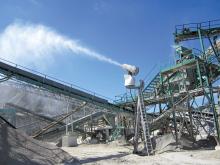
While ancillary equipment such as graders, bowsers and dust control equipment might not be the bread and butter of a quarry business, such kit has a valuable role to play in keeping frontline machinery as productive as possible
With the cost of replacing six 27.00 R49 tyres for your average 100tonne rigid quarry truck costing upwards of £50,000 (€59,000), it stands to reason that haul roads need to be properly maintained if tyre life is to be maximised and running costs are to be contained. And most operators are all too aware that good housekeeping starts with site maintenance.
A smooth, even road surface allows trucks to maintain their travel speeds, while preventing undue stress on tyres, suspension and chassis. And this often requires a dedicated focus and must be addressed on an almost continual basis.
There are rolling resistance issues to consider too, which will have an impact on fuel consumption. Operators using a fleet of mixed sized articulated haulers will, for example, create different sized wheel ruts in soft conditions because of the different wheel and tyre equipment and also the varied wheel track widths of different sized haulers.
It is also important to plan haul routes and manage gradients. Far better to have a shallower gradient to allow a truck to make a climb in second gear if possible, rather than first, and it will use less fuel and travel slightly quicker, helping to contain cost and boost productivity.
Top of the wish-list could perhaps be a motor grader, and there have been plenty of developments in this sector with the most recent being the M-series 2 models from
Equipped with clean-burning, fuel-efficient engines meeting Tier 4 Interim/Stage IIIB emissions standards, the 140M2 and 160M2 are said to deliver added value for the customer by lowering operating costs and enhancing productivity, operator convenience and serviceability.
Cat has achieved this by giving the M2 a pair of electronic joystick controls that result in nearly 80% fewer hand and wrist movements compared to conventional motor grader controls.
An advanced, electro-hydraulic control system is available for implement control and the models can be equipped with Cat Grade Control Cross Slope capability. This integrated technology further simplifies machine operation and helping both new and experienced operators to be more productive. In addition, Cat Cross Slope is fully upgradeable and compatible with AccuGrade systems, enabling such systems to grow with customers’ needs.
While graders might be the obvious choice, there are other options for equipment suitable to the task. For David Glenn, managing director at Naunton, Gloucester-based Huntsmans Quarries in England the requirement for haul road maintenance is reflected in the role of a dozer to keep surfaces smooth and clean.
“Tyre damage and premature tyre wear can represent a massive cost to any quarry business, and the best way to manage tyre life is to take care of the haul roads,” he says. “It’s an easy way to make sure we get the best out of our ADTs, and that doesn’t always mean running them as fast as possible to maximise productivity.”
Five articulated dump trucks are in service at Huntsmans, and are used to haul stone to the crusher in addition to removing overburden. David Glenn’s focus on efficiency has been driven by the market drop in demand for aggregates, which has seen Huntsmans’ annual output reduced from 300,000tonnes of Cotswold stone to just 200,000tonnes per year.
“We can allocate specific days for muck-shifting and specific days for crushing, so we can tailor our resources precisely to the needs of our customers,” he says. It is also one of the reasons why he keeps a 1997-model Cat D6R on his fleet.
“With the current output significantly reduced from two or three years ago, we have restructured our fleet and production cycles to give flexibility in our system so that I can keep men and machines working.”
The D6R at
“My primary need for a dozer is for reinstatement and restoration of the landscape once we’ve removed stone from the site, and it just so happens to be a useful tool for tidying up haul roads when ground conditions dictate that road surfaces need a little attention. I just couldn’t justify a grader,” he says.
“As it is, the dozer often only works on Fridays and Saturday mornings for reinstatement works. To meet this need from hiring in would be an expensive option given the amount of work I have for a dozer, and I’d rather keep the money with my own employees who have the operating skills.”
It might seem an obvious one, but the very nature of mineral extraction creates dust, and lots of it (see also Dust busters this issue). From drilling and blasting through to mobile plant moving around, dust and silica remains a significant hazard that can interfere with productivity in a number of ways. And the need for effective dust suppression is of equal importance to having a well-constructed and maintained haul road.
Dust thrown up by dump trucks can reduce visibility and mobility, and the easiest way to deal with this is to use a water bowser, with tanker size determined by several factors including the length of the haul road and the location of fill-up points.
In addition to dust suppression, it has been found that regular watering helps to maintain surface compaction on haul roads. Conversely, it is possible to over-water. This can have the effect of washing out fines from the surface of the road and this can lower the frictional properties of the road surface, quickly causing the surface to deteriorate and potholes to appear.
Dust can also have a detrimental effect on filters for cabs and engines, which can require frequent attention, and any clean-up of dust from cabs or work stations is best carried out with a vacuum cleaner.
Brushing dust, says the UK’s
An innovative dust suppression solution is available with models from Comac Environmental UK, in the guise of the AkkuaJet 35S and 65S models. Available with crawler undercarriage and trailer-mount formats, both models operate is a similar fashion. The 35S and 65S use a ring of nozzles contained in a boom-mounted fan system which blasts atomised water over a distance of 35m and 65m respectively, hence the model numbering.
The variable height hydraulic mast affords tilt and 360° head rotation throughout its 5.5m working height. Power comes from an on-board diesel gen-set giving electrical power to run the pumps and motors needed to create 15bar of working pressure for the dust suppression system.
The fully-programmable AkkuaJet can also be equipped with a remote radio control system enabling the loader operator to constantly adjust the machine’s position and output to suit changing wind direction and dust creation.
However, water is considered only a short-term solution for dust suppression, and can soon evaporate. Those seeking longer term solutions might be interested in a soil sealant, such as Top Seal from
Top Seal is a soil sealant and stabiliser that can be used to coat a haul road in addition to providing greater stability to the surface to prevent run-off and erosion. It is mixed with water and applied to the scarified road, to allow the liquid solution to penetrate and mix into the soil. Three applications are generally required, says SCI, to give the desired level of soil bonding.
Although the cost of the first year of a haul road dust control programme with this treatment will generally not exceed the actual or estimated cost of daily watering operations, says the company, after the first year the cost of continued maintenance will be significantly lower than daily watering operations.
Over a period of several years, the savings can accumulate to as much as 75%, says SCI.


